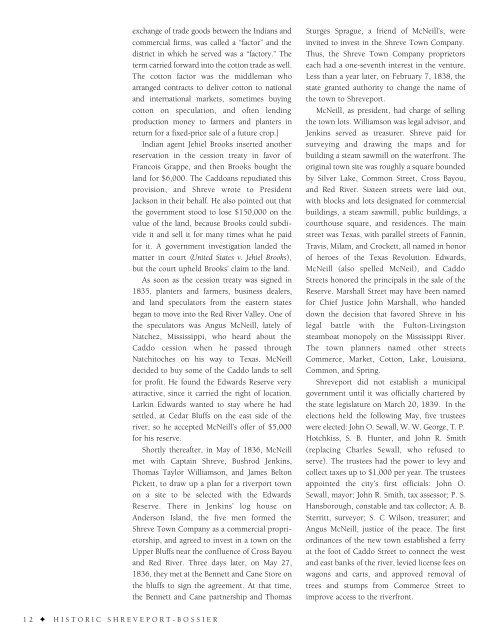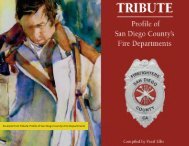Historic Shreveport-Bossier
An illustrated history of the Shreveport-Bossier City area, paired with the histories of companies, families and organizations that make the region great.
An illustrated history of the Shreveport-Bossier City area, paired with the histories of companies, families and organizations that make the region great.
You also want an ePaper? Increase the reach of your titles
YUMPU automatically turns print PDFs into web optimized ePapers that Google loves.
exchange of trade goods between the Indians and<br />
commercial firms, was called a “factor” and the<br />
district in which he served was a “factory.” The<br />
term carried forward into the cotton trade as well.<br />
The cotton factor was the middleman who<br />
arranged contracts to deliver cotton to national<br />
and international markets, sometimes buying<br />
cotton on speculation, and often lending<br />
production money to farmers and planters in<br />
return for a fixed-price sale of a future crop.]<br />
Indian agent Jehiel Brooks inserted another<br />
reservation in the cession treaty in favor of<br />
Francois Grappe, and then Brooks bought the<br />
land for $6,000. The Caddoans repudiated this<br />
provision, and Shreve wrote to President<br />
Jackson in their behalf. He also pointed out that<br />
the government stood to lose $150,000 on the<br />
value of the land, because Brooks could subdivide<br />
it and sell it for many times what he paid<br />
for it. A government investigation landed the<br />
matter in court (United States v. Jehiel Brooks),<br />
but the court upheld Brooks’ claim to the land.<br />
As soon as the cession treaty was signed in<br />
1835, planters and farmers, business dealers,<br />
and land speculators from the eastern states<br />
began to move into the Red River Valley. One of<br />
the speculators was Angus McNeill, lately of<br />
Natchez, Mississippi, who heard about the<br />
Caddo cession when he passed through<br />
Natchitoches on his way to Texas. McNeill<br />
decided to buy some of the Caddo lands to sell<br />
for profit. He found the Edwards Reserve very<br />
attractive, since it carried the right of location.<br />
Larkin Edwards wanted to stay where he had<br />
settled, at Cedar Bluffs on the east side of the<br />
river, so he accepted McNeill’s offer of $5,000<br />
for his reserve.<br />
Shortly thereafter, in May of 1836, McNeill<br />
met with Captain Shreve, Bushrod Jenkins,<br />
Thomas Taylor Williamson, and James Belton<br />
Pickett, to draw up a plan for a riverport town<br />
on a site to be selected with the Edwards<br />
Reserve. There in Jenkins’ log house on<br />
Anderson Island, the five men formed the<br />
Shreve Town Company as a commercial proprietorship,<br />
and agreed to invest in a town on the<br />
Upper Bluffs near the confluence of Cross Bayou<br />
and Red River. Three days later, on May 27,<br />
1836, they met at the Bennett and Cane Store on<br />
the bluffs to sign the agreement. At that time,<br />
the Bennett and Cane partnership and Thomas<br />
Sturges Sprague, a friend of McNeill’s, were<br />
invited to invest in the Shreve Town Company.<br />
Thus, the Shreve Town Company proprietors<br />
each had a one-seventh interest in the venture.<br />
Less than a year later, on February 7, 1838, the<br />
state granted authority to change the name of<br />
the town to <strong>Shreveport</strong>.<br />
McNeill, as president, had charge of selling<br />
the town lots. Williamson was legal advisor, and<br />
Jenkins served as treasurer. Shreve paid for<br />
surveying and drawing the maps and for<br />
building a steam sawmill on the waterfront. The<br />
original town site was roughly a square bounded<br />
by Silver Lake, Common Street, Cross Bayou,<br />
and Red River. Sixteen streets were laid out,<br />
with blocks and lots designated for commercial<br />
buildings, a steam sawmill, public buildings, a<br />
courthouse square, and residences. The main<br />
street was Texas, with parallel streets of Fannin,<br />
Travis, Milam, and Crockett, all named in honor<br />
of heroes of the Texas Revolution. Edwards,<br />
McNeill (also spelled McNeil), and Caddo<br />
Streets honored the principals in the sale of the<br />
Reserve. Marshall Street may have been named<br />
for Chief Justice John Marshall, who handed<br />
down the decision that favored Shreve in his<br />
legal battle with the Fulton-Livingston<br />
steamboat monopoly on the Mississippi River.<br />
The town planners named other streets<br />
Commerce, Market, Cotton, Lake, Louisiana,<br />
Common, and Spring.<br />
<strong>Shreveport</strong> did not establish a municipal<br />
government until it was officially chartered by<br />
the state legislature on March 20, 1839. In the<br />
elections held the following May, five trustees<br />
were elected: John O. Sewall, W. W. George, T. P.<br />
Hotchkiss, S. B. Hunter, and John R. Smith<br />
(replacing Charles Sewall, who refused to<br />
serve). The trustees had the power to levy and<br />
collect taxes up to $1,000 per year. The trustees<br />
appointed the city’s first officials: John O.<br />
Sewall, mayor; John R. Smith, tax assessor; P. S.<br />
Hansborough, constable and tax collector; A. B.<br />
Sterritt, surveyor; S. C Wilson, treasurer; and<br />
Angus McNeill, justice of the peace. The first<br />
ordinances of the new town established a ferry<br />
at the foot of Caddo Street to connect the west<br />
and east banks of the river, levied license fees on<br />
wagons and carts, and approved removal of<br />
trees and stumps from Commerce Street to<br />
improve access to the riverfront.<br />
12 ✦ HISTORIC SHREVEPORT-BOSSIER
















